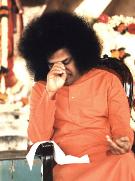 There is a rose plant. It has leaves,
thorns and rose flowers. Concentration helps you to identify as to where the
thorns are and where the rose flower is. In concentration, we have only rose
as the objective, without touching the thorns we have to pluck the flower.
"Love is flower; lust is thorn." There is no rose without thorns but we have
to pluck the flower without touching the thorns. For what purpose is this
cutting of rose? To cut the love (flower) away from worldly desires (thorns)
is contemplation. Concentration is identifying the various locations of the
thorns and flowers by looking at the tree/plant. To offer the flower so cut,
to the Lord is meditation. In our body likened to that of a rose plant, we
have pure love in the form of rose. It is permeated with fragrance/good
smell of virtues. But right under this are the thorns of worldly desires.
True meditation is to identify the thorns of worldly desires from selfless
love and offer that selfless love to the Lord. From ancient days, meditation
has been considered as the highest goal in Bharat. Today meditation is done
as though it were a panacea akin to saridon which removes headache.
Meditation that comes so easily cannot be termed as such. People such as
Narada, Sanaka, Sanandana, Sanat Kumara and Tumbura considered meditation to
be the process of sending the Kundalini from Muladhara to Sahasrara. During
meditation, one should not join worldly desires and must reach only selfless
love as the goal. The method/posture of meditation is also very important.
There is a rose plant. It has leaves,
thorns and rose flowers. Concentration helps you to identify as to where the
thorns are and where the rose flower is. In concentration, we have only rose
as the objective, without touching the thorns we have to pluck the flower.
"Love is flower; lust is thorn." There is no rose without thorns but we have
to pluck the flower without touching the thorns. For what purpose is this
cutting of rose? To cut the love (flower) away from worldly desires (thorns)
is contemplation. Concentration is identifying the various locations of the
thorns and flowers by looking at the tree/plant. To offer the flower so cut,
to the Lord is meditation. In our body likened to that of a rose plant, we
have pure love in the form of rose. It is permeated with fragrance/good
smell of virtues. But right under this are the thorns of worldly desires.
True meditation is to identify the thorns of worldly desires from selfless
love and offer that selfless love to the Lord. From ancient days, meditation
has been considered as the highest goal in Bharat. Today meditation is done
as though it were a panacea akin to saridon which removes headache.
Meditation that comes so easily cannot be termed as such. People such as
Narada, Sanaka, Sanandana, Sanat Kumara and Tumbura considered meditation to
be the process of sending the Kundalini from Muladhara to Sahasrara. During
meditation, one should not join worldly desires and must reach only selfless
love as the goal. The method/posture of meditation is also very important.
In the beginning, we must sit in
Padmasana. Spinal column should not bend to any side. Some people bend the
neck and sit. This is very dangerous. If Kundalini power were to get locked
there, where many nerves are present, it would damage the person and cause
paralysis. There are many who have damaged their heads/senses by wrongly
adhering to Kundalini. One should not bend backwards either. One should be
so straight that if a nail were to be driven down from Sahasrara, it should
appear as though the whole body were wrapped around the nail. Not only that,
one should loosen the garment that is around the waist prior to sitting for
meditation. If the garment is tightly wound round the waist, it might, to an
extent, obstruct the Kundalini. Usually people who practise Kundalini yoga
are single garmented. So, waist should not be tightly bound. Vision should
be centred at the tip of the nose. If one were to sit for meditation with
open eyes, all those who pass by would cause disturbance to the mind. If
eyes are totally closed, the goddess of sleep would envelop us. Therefore,
we should have half closed eyes posture. Some believe the tip of the nose to
be between the eye brows. No! It is forehead; It is the end of nose. i.e.,
Tip of the nose that has to be concentrated upon. Lord Krishna has also
described the same.
"Kasturi Tilakam Lalaata(1) Phalake
Vaksha(2) Sthale Kausthubam Naasagre(3) Navamouktikam..."
1) Refers to the eye of wisdom.
2) Lord
Krishna adorned his chest with the plaque of happiness.
3) He kept his vision
fixed on the tip of his nose. Such a Krishna had two bracelets on His hand.
One bracelet signifies -
"Save the righteous and punish the
wicked"
The second bracelet signifies -
"One who constantly relies on me, I
shall take care of all his needs".
God wears bracelets for fulfilling vows.
So, Lord Krishna's vision was on the tip of His nose i.e., always
meditative. We may have to observe certain physical activities. Mind is very
much wavering. Knowing fully well that something is wrong, it would like to
do it. We know well that to hear bad things is not good and yet we do it. We
should teach it a lesson.
"O ears! Why do you go after listening
to the tales of all and sundry? When the Lord's name is chanted, why don't
you pay heed?"
You should teach the ears to listen to
tales that would give happiness to all and such facts that would gloria the
Lord.
"You go and see films, which do you no
good, again and again. But you do not wish to contemplate on the Lord even
for a moment. O eyes! Pay heed."